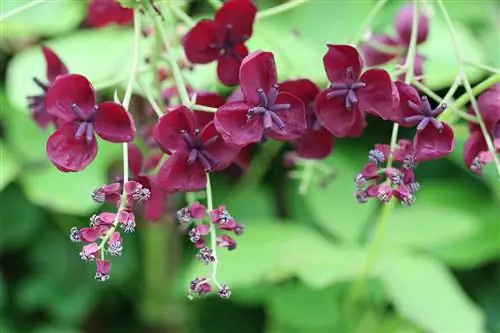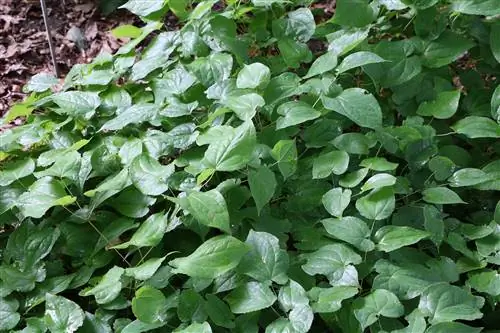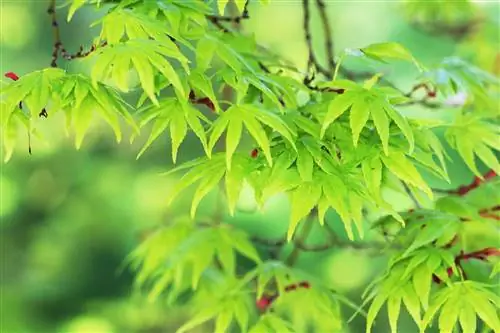- Author admin [email protected].
- Public 2023-12-17 03:39.
- Last modified 2025-01-24 12:45.
The chocolate wine presents itself fragrant and attractive in the garden or on the terrace over the spring. Caring for the climbing plant is not difficult.
Profile
- Plant family: Finger fruit family (Lardizabalaceae)
- Genus: Akebia (Akebia)
- Synonyms: five-leaved akebia, finger-leaved akebia, climbing cucumber, blue cucumber wine
- Origin: Japan, Korea, China
- Growth habit: upright, climbing plant, woody, deciduous or evergreen
- Growth height: up to 1,200 cm
- Leaves: 2 cm to 7 cm long, glabrous, egg-shaped, top green, bottom blue-green
- Flowers: white, pink, purple, violet, 1 cm tall (male), 2.5 cm tall (female), grow together in flower clusters
- Flowering period: April to the end of May
- Flowers smell spicy like chocolate and vanilla
Location
The chocolate wine is not complicated in terms of care, as long as you choose the right location for the plant. This is crucial because it allows it to spread and grow in a relaxed manner. She prefers the following location characteristics:
- Light requirements: sunny to partially shaded
- warm
- sheltered from the wind
- ideally in front of stone walls
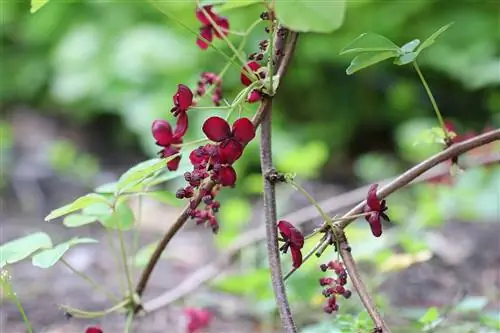
Floor
In addition to the right location, the finger-leaved akebia needs good soil, especially if you decide to plant it outdoors. The following properties should be taken into account:
- normal garden soil
- loamy-sandy
- humos
- permeable
- easy
- can tolerate limescale
- pH value: 5.0 to 8.0
Plants
Planting outdoors is just as easy as the rest of the Akebia quinata care measures. The most important point is the period in which the chocolate wine is planted so that it can establish itself in its new location by winter. The following instructions will help you:
- Period: April to May
- Planting distance: 100 cm to 150 cm
- same distance from walls or other structures
- Dig planting hole
- Planting hole slightly larger than root ball5n
- Enrich excavated earth with quartz sand, if compacted
- Create drainage on the floor
- Drainage material: gravel, grit
- Removing the plant from the pot
- Check roots
- remove damaged or dead roots
- place in planting pit
- align
- Fill planting hole with excavated soil
- press lightly
- Provide plant with climbing aid
- pour well
Substrate
If you want to cultivate the finger-leaved akebia in a pot, you need the right substrate. Fortunately, chocolate wine does not place great demands on the substrate and can therefore be cultivated without any problems. Ideally, you should use garden or pot plant soil with the same properties as for outdoor planting.
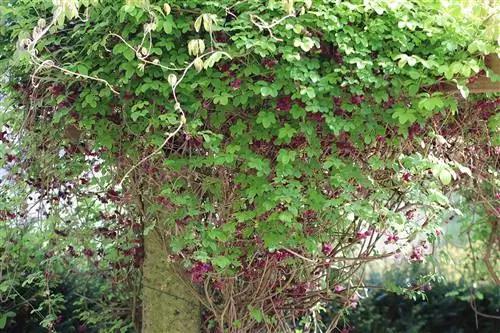
Repotting
The chocolate wine is repotted every two to three years so that the roots have fresh substrate available. At the same time, it spreads quite a bit in the bucket within this time and a larger one is needed. So select this before repotting so that the plant has enough space in the new pot. In addition, it should have drainage holes. Repotting takes place in spring as follows:
- Remove plant from old pot
- Free roots from soil
- Check roots
- remove damaged, rotten, dried or broken roots
- Create drainage on the floor
- Drainage material: gravel, pottery shards
- cover with garden fleece
- fill in some substrate
- Insert chocolate wine
- align
- fill with substrate
- Press the substrate lightly
- Add climbing aid
Pouring
A chocolate wine is always watered as needed. Outdoor plants do not need additional water unless it has been very dry for a long period of time. In this case, check the soil using the finger sample to see whether the finger-leaved akebia needs water. Container specimens also only need to be watered as needed. However, check the plant's substrate at regular intervals to prevent it from drying out. A slightly moist substrate is never a bad idea. You can use hard or low-calcium water.
Fertilize
Nutrients are important for Akebia quinata so that it blooms vigorously. Fertilization is only carried out from spring to autumn because it does not need any additional nutrients in winter. The following fertilizers are used:
- Outdoor specimens: incorporate compost in spring
- Container plants: vegetable plant liquid fertilizer (short or long term)
- Frequency of liquid fertilizer according to manufacturer's information
- Administer exclusively via irrigation water
Cutting
The thinning cut is important so that the Akebia quinata does not become bald. If neglected, it has a strong tendency to do so. Thinning is necessary every two years in the spring before budding. However, if the plant is bare, you can cut back some of the main shoots inside and then carefully shorten everything. Since the chocolate wine is very easy to cut, you don't have to worry. The following steps will help you implement it:
- Disinfect and sharpen secateurs
- remove dried, bare or broken shoots
- especially inside the plant
- prune shoots that have grown too high to their total height
- Dispose of clippings
Harvesting
The fruits of Akebia quinata are not poisonous and can be eaten without any problems. In order for your finger-leaved akebia to bear fruit, you need at least two specimens so that they can cross-pollinate. Fruits can form after the plant has flowered for the first time, about five years. Harvesting takes place from the beginning of September to mid-October and no earlier. Although the chocolate wine fruits are not poisonous, you should still make sure to only harvest ripe fruits. Unripe fruits are also not poisonous, but are indigestible and difficult to digest. So wait until autumn to harvest.
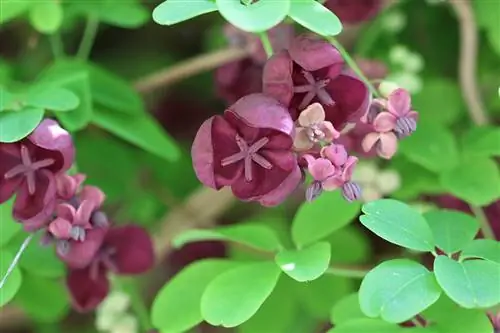
Note:
In Central Europe, chocolate wine fruits only form in regions with mild winters, for example wine-growing areas.
Wintering
You don't have to do much to overwinter the chocolate wine. The outdoor specimens can withstand temperatures down to -10°C, although rough conditions or wind can be dangerous. So that it doesn't get too frosty during the cold season, wrap the planted specimens in a garden fleece and cover the location with brushwood or dry leaves. If you have a container plant, do the following:
- Place the pot protected from the wind
- place on Styrofoam
- Wrap the pot and plant in bubble wrap or garden fleece
- water carefully on days without frost
Note:
You can tell whether it is too cold for chocolate wine when the leaves fall off over the winter. In this case, equip the plant with winter protection afterwards.
Propagation
Ideally, chocolate wine is propagated through sowing. This is particularly easy if your specimens have produced fruits whose seeds you can use. Alternatively, you can purchase the seeds commercially. A bag of ten seeds costs on average between five and ten euros. If you use self-harvested fruits as a source for the seeds, you must completely remove the pulp from them, otherwise they will rot in the substrate. They are then stored dry and warm over the winter. The ideal time for sowing is in spring from April to May. Follow these instructions:
- Substrate: potting soil
- sterilize beforehand
- Fill cultivation pots with soil
- plant 1 seed per pot
- put out into the open
- Location: bright, protected
- keep moist
- don't get wet
- Prick out and repot young plants after germination
- leave in the pot until next year
- winter well
- plant out next spring or repot again
- optional: equip with climbing aid
Note:
Alternatively, you can propagate the chocolate wine naturally using planters when shoots touch the ground. These are then weighed down, separated after rooting and transplanted.
Mildew
The chocolate vine is a robust plant that has no real problem with diseases or pests. The only problem can be an infestation by powdery mildew, but this is not dangerous for the Akebia quinata. However, you should not ignore mildew completely, as the fungal disease could affect larger areas due to care errors. If the disease spreads, you should use fungicides, as home remedies such as milk do not work with akebia.

